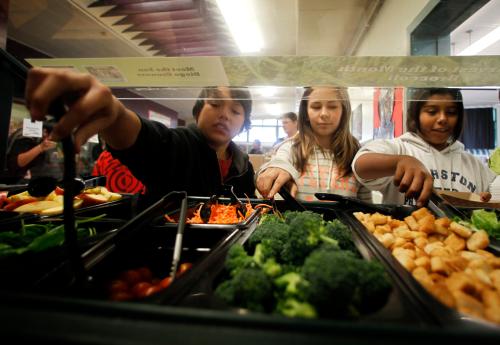The federal school-meals program is the largest form of nutritional assistance to school-age children, accounting for half of the food consumption among children who participate and subsidizing free or reduced-price meals for more than 22 million students in the 2018-19 school year (approximately 40% of children ages 5-17). Known as the National School Lunch Program, it has substantially changed over the past decade: Historically, only students from low-income families received free meals, but schoolwide free-meal programs—in which all students in a school receive free meals regardless of their own families’ income—are becoming increasingly common. In the 2018-19 school year, more than one-quarter of students attended a school that provided breakfasts and lunches to all students at no cost.
Even before the pandemic brought food insecurity to alarming levels, hunger and insufficient nutritional access were acute concerns for many families. In 2019, nearly 14% of families with children experienced food insecurity. Previous work has shown that greater nutritional assistance through programs like SNAP and the school meals program can reduce food insecurity and improve nutritional intake. Yet, prior work on how free school meals affect student performance has reached mixed conclusions. Here, I describe some new findings about the impact of free meals on students, using recent administrative changes that expanded schoolwide programs.
An integral part of the shift toward schoolwide free-meal provision was the Community Eligibility Provision (CEP), introduced as part of the Healthy, Hunger-Free Kids Act of 2010. Under CEP, schools and districts where at least 40% of students received another form of means-tested assistance (most commonly SNAP) could offer free meals to all students, with federal reimbursement based on the share of students receiving other forms of assistance. In addition to expanding access to free meals to students who might not otherwise qualify, schoolwide free-meals programs—including CEP—aim to reduce administrative burdens for schools by relying on income information that was already collected by the federal government and reported to districts.
CEP began as a pilot program in Illinois, Kentucky, and Michigan in the 2011-12 school year. Schools in four additional states could participate in each of the following two years, and the remaining 40 states were eligible beginning in 2014-15. Participation among eligible schools and districts has increased each year, so that by the 2019-20 school year, 69% of eligible schools participated.
In two studies, I use this staggered national implementation and variation in when schools and districts adopted CEP to examine how schoolwide free meals affect student outcomes. This framework allows me to compare changes within a district or school before and after CEP adoption, relative to other areas that eventually participated in CEP but did so in a different year. There are three takeaways from this work:
First, schoolwide free meals increase the number of school breakfasts and lunches served. Using administrative data collected from state departments of education on the number of meals served at each school, I find that this measure increases in schools where many students became newly eligible for free meals after CEP, as well as in schools that previously had high rates of free-meal eligibility. This pattern is consistent with the schoolwide nature of free-meal programs reducing stigma and facilitating greater access, as found in other work.
Second, schoolwide free meals improve math performance in districts where relatively few students qualified under the income-based program. Within these districts, elementary and Hispanic students experience the largest academic improvements. Figure 1 summarizes how free meals through CEP affect math performance among different groups of students in these districts with low free-meal participation before CEP. In this figure, the height of the bars shows the estimated impacts and the vertical lines shows the 90% confidence interval. I find that overall math performance improved about 0.016 standard deviations. Elementary students improved more than average, about 0.020 standard deviations. Finally, Hispanic students’ performance improved the most among all racial/ethnic groups—about 0.034 standard deviations.
Third, schoolwide free-meal programs significantly reduce suspensions among white male elementary students. In work co-authored with Nora Gordon, we find CEP reduced the number of out-of-school suspensions among white male elementary students by approximately 17%. Our estimates for other elementary subgroups suggest fewer suspensions, but these results are smaller in magnitude and generally insignificant.
That improved math performance and fewer suspensions are found in areas and among subpopulations with low free-meal participation before CEP is consistent with the nature of the program. Specifically, schoolwide free-meal programs increase access for families who don’t qualify under the income-based formula—both families with income above 130% of the poverty line, as well as families that do not complete income questionnaires that determine eligibility. On the other hand, students who were previously certified have the same access to free meals before and after CEP, and the move to schoolwide provision does not change the amount of nutritional assistance that they receive. While my findings are unique in leveraging national data that allow for cross-state comparisons over time, other work that evaluates the experiences of a single state reaches similar conclusions: In general, benefits are concentrated among younger students and groups that are most likely to gain access under universal programs.
Taken together, these results suggest that free school meals, in addition to providing nutritional benefits, can improve students’ academics and discipline. Even during the pandemic crisis, when students are not receiving in-person instruction, there is reason to believe schoolwide free-meals programs may still help students. All students eligible for free meals, including all students who attend a CEP school, can receive greater nutritional assistance for groceries through the Pandemic-EBT (P-EBT) program. Given the high rates of food insecurity experienced among families with children since the start of the pandemic, and the role of P-EBT in reducing this hardship, benefits of schoolwide free-meals programs may extend beyond the classroom as well.
The Brookings Institution is committed to quality, independence, and impact.
We are supported by a diverse array of funders. In line with our values and policies, each Brookings publication represents the sole views of its author(s).








